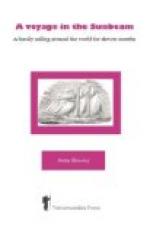[Illustration: Chalcedon Imperator.]
From the fish-market we went to the prison, a large and apparently admirably managed establishment, built of stone, and overlooking the harbour. After a pleasant drive along shady fragrant roads, we returned to Emma Square, to hear the excellent performance of the Saturday afternoon band. There was a good assemblage of people, on horseback, in carriages, and on foot, and crowds of children, all more or less white, languid, and sickly-looking. Poor mites! I suppose the climate is too hot for European constitutions. Still, they abound among the foreigners, while the natives are gradually, but surely, dying out. Among the whole royal family there is only one child, a dear little girl of rather more than a year old. Princess Kauilani (’Sent from Heaven’) she is always called, though she has a very long string of additional names. She is heiress-presumptive to the throne, and is thought a good deal of by everybody. Among twenty of the highest chiefs’ families there is only one baby. On the other hand, all the foreign consuls, ministers, missionaries, and other white residents, appear to have an average of at least half a dozen in each family.
After the performance was over, we walked to the Princess Likelike’s house, where we were entertained at a poi supper. The garden was illuminated, the band played and a choir sang alternately, while everybody sat out in the verandah, or strolled about the garden, or did what they liked best. Prince Leleiohoku took me in to supper, which was served in the native fashion, in calabashes and on leaves, laid on mats on the floor, in the same manner as the feast at Tahiti. The walls of the dining-room were made of palm-leaves and bananas, and the roof was composed of the standards of the various members of the royal family, gracefully draped. At one end of the long table, where the Prince and I sat, there was his special royal standard, as heir-apparent, and just behind us were stationed a couple of women, with two large and handsome kahilis, which they waved incessantly backwards and forwards. The viands were much the same as at Tahiti—raw seaweed, which was eaten with each mouthful, being substituted for the chopped cocoa-nut and salt-water. The carved koa bowls, which were in constant requisition as finger-glasses, were specially elegant and useful-looking articles. Poi is generally eaten from a bowl placed between two people, by dipping three fingers into it, giving them a twirl round, and then sucking them. It sounds rather nasty; but, as a matter of fact, it is so glutinous a mixture that you really only touch the particles that stick to your fingers. The latter you wash after each mouthful, so that there is nothing so very dreadful about it after all. There was a quantity of raw fish, which I did not touch, but which some of our party thought most excellent, besides dried and cooked fish, which seemed very good, fried candle-nuts, baked pig, and many other delicacies. We could get however, nothing to drink. After supper, we returned to the house, where we found an abundance of champagne and other wines, cakes, and biscuits.




